初三被动语态详细讲解
初中英语被动语态讲解
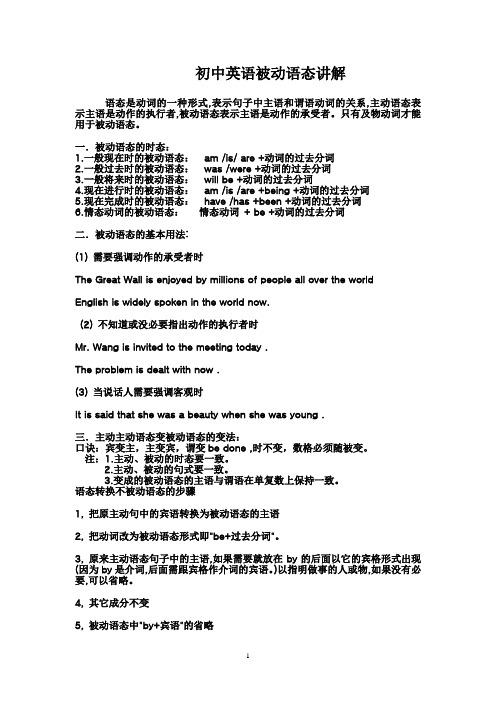
初中英语被动语态讲解语态是动词的一种形式,表示句子中主语和谓语动词的关系,主动语态表示主语是动作的执行者,被动语态表示主语是动作的承受者。
只有及物动词才能用于被动语态。
一.被动语态的时态:1.一般现在时的被动语态:am /is/ are +动词的过去分词2.一般过去时的被动语态:was /were +动词的过去分词3.一般将来时的被动语态:will be +动词的过去分词4.现在进行时的被动语态:am /is /are +being +动词的过去分词5.现在完成时的被动语态:have /has +been +动词的过去分词6.情态动词的被动语态:情态动词+ be +动词的过去分词二.被动语态的基本用法:(1) 需要强调动作的承受者时The Great Wall is enjoyed by millions of people all over the worldEnglish is widely spoken in the world now.(2) 不知道或没必要指出动作的执行者时Mr. Wang is invited to the meeting today .The problem is dealt with now .(3) 当说话人需要强调客观时It is said that she was a beauty when she was young .三.主动主动语态变被动语态的变法:口诀:宾变主,主变宾,谓变be done ,时不变,数格必须随被变。
注:1.主动、被动的时态要一致。
2.主动、被动的句式要一致。
3.变成的被动语态的主语与谓语在单复数上保持一致。
语态转换不被动语态的步骤1, 把原主动句中的宾语转换为被动语态的主语2, 把动词改为被动语态形式即"be+过去分词"。
3, 原来主动语态句子中的主语,如果需要就放在by的后面以它的宾格形式出现(因为by是介词,后面需跟宾格作介词的宾语。
初中英语被动语态讲解
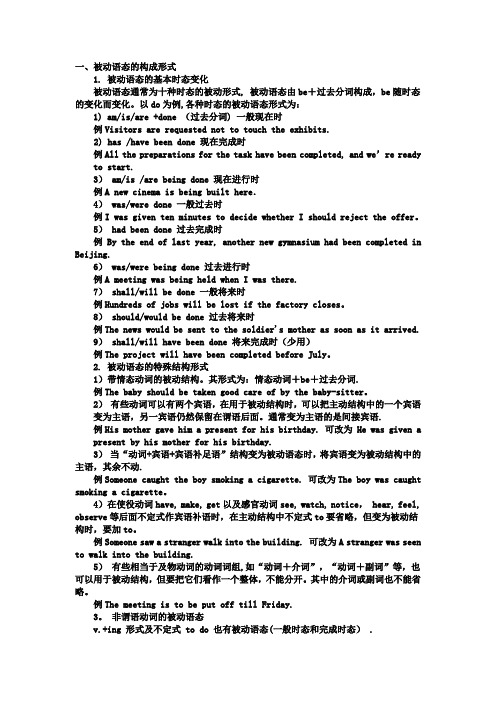
一、被动语态的构成形式1. 被动语态的基本时态变化被动语态通常为十种时态的被动形式, 被动语态由be+过去分词构成,be随时态的变化而变化。
以do为例,各种时态的被动语态形式为:1) am/is/are +done (过去分词) 一般现在时例Visitors are requested not to touch the exhibits.2) has /have been done 现在完成时例All the preparations for the task have bee n completed, and we’re ready to start.3) am/is /are being done 现在进行时例A new cinema is being built here.4) was/were done 一般过去时例I was given ten minutes to decide whether I should reject the offer。
5) had been done 过去完成时例 By the end of last year, another new gymnasium had been completed in Beijing.6) was/were being done 过去进行时例A meeting was being held when I was there.7) shall/will be done 一般将来时例Hundreds of jobs will be lost if the factory closes。
8) should/would be done 过去将来时例The news would be sent to the soldier's mother as soon as it arrived.9) shall/will have been done 将来完成时(少用)例The project will have been completed before July。
中考英语被动语态用法讲解
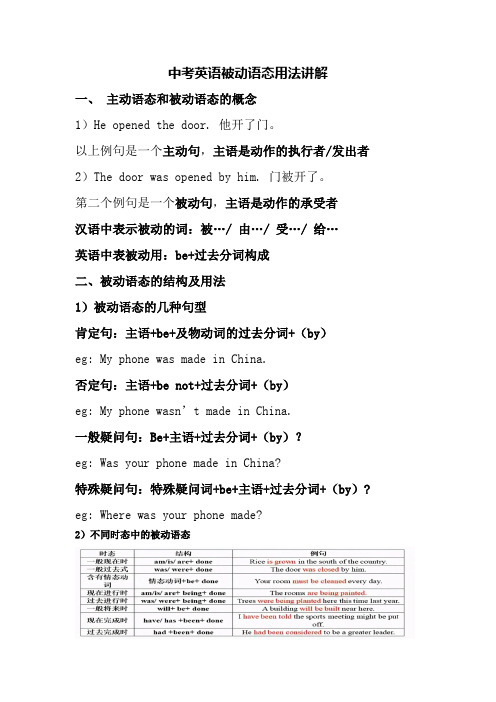
中考英语被动语态用法讲解一、主动语态和被动语态的概念1)He opened the door. 他开了门。
以上例句是一个主动句,主语是动作的执行者/发出者2)The door was opened by him. 门被开了。
第二个例句是一个被动句,主语是动作的承受者汉语中表示被动的词:被…/由…/受…/给…英语中表被动用:be+过去分词构成二、被动语态的结构及用法1)被动语态的几种句型肯定句:主语+be+及物动词的过去分词+(by)eg: My phone was made in China.否定句:主语+be not+过去分词+(by)eg: My phone wasn’t made in China.一般疑问句:Be+主语+过去分词+(by)?eg: Was your phone made in China?特殊疑问句:特殊疑问词+be+主语+过去分词+(by)? eg: Where was your phone made?2)不同时态中的被动语态3)被动语态的用法当不知道或没有必要指出动作的执行者时,常用被动语态,这时往往不用by短语。
The front window in the classroom was broken yesterday.昨天,教室的前窗被打破了。
(不知谁打破的)They have been poorly paid.他们的工资太低。
(没必要指出工资是谁付的)突出或强调动作的承受者,如果需要说出动作的执行者,用by 短语。
These books are written especially for children.这些书是专门为孩子们写的。
(强调的是“这些书”)三、主动语态变被动语态1)一般情况下主动语态变被动语态主动句:He closed the door.变被动句:The door was closed by him.口诀:宾变主,主变宾,谓变be done, 时不变,数格必须随被变。
中考英语被动语态知识点讲解
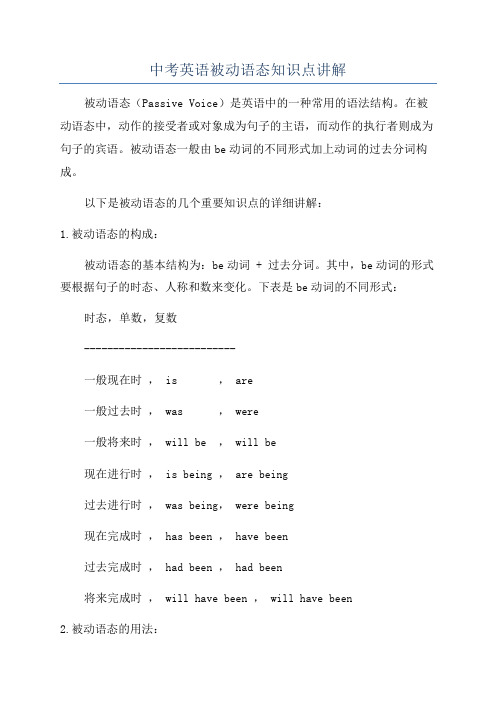
中考英语被动语态知识点讲解被动语态(Passive Voice)是英语中的一种常用的语法结构。
在被动语态中,动作的接受者或对象成为句子的主语,而动作的执行者则成为句子的宾语。
被动语态一般由be动词的不同形式加上动词的过去分词构成。
以下是被动语态的几个重要知识点的详细讲解:1.被动语态的构成:被动语态的基本结构为:be动词 + 过去分词。
其中,be动词的形式要根据句子的时态、人称和数来变化。
下表是be动词的不同形式:时态,单数,复数--------------------------一般现在时, is , are一般过去时, was , were一般将来时, will be , will be现在进行时, is being , are being过去进行时, was being, were being现在完成时, has been , have been过去完成时, had been , had been将来完成时, will have been , will have been2.被动语态的用法:被动语态常用于以下情况:- 当行为执行者不重要或不知道时,一般用被动语态。
例如:The car was repaired yesterday.(这辆车昨天被修好了。
)- 当强调动作的承受者而不是执行者时,使用被动语态。
例如:The book was written by a famous author.(这本书是由一位著名作家写的。
)- 当句子的主语是一个无生命的物体时,常用被动语态。
例如:The window was broken by the wind.(窗户被风摔坏了。
)3.需要注意的细节:- 当句子的主语是第三人称单数时,be动词的形式要用is,而不是are。
例如:The book is being read by my sister.(这本书正在我妹妹看。
)- 当使用被动语态时,动词的过去分词形式要正确使用。
九年级英语被动语态详解

主语 谓语
宾语
(2) The school set up a special class to help poor readers.
→ A special class to help poor readers was set up in the school.
1.把主动语态的宾语变成被动语态的主语。 2.把主动语态的谓语变成被动语态的be + 过去分词,时态要与原 句保持一致。 3.把主动语态的主语变为介词by 的宾语,放在被动语态里谓语动 词之后,by 短语可以省略。如果原句主语是地点名词,在被动语 态中用in + 地点名词作状语。
汉语中常用“被”、“给”、“由”、“受”等词用 来表示被动,而英语用:助动词be + 及物动词的过去分 词构成。
(五பைடு நூலகம்主动语态变被动语态的方法
(1) My aunt invited me to her dinner party. 主语 谓语 宾语
→ I was invited (by my aunt ) to her dinner party.
如果把直接宾语(指物)改为主语,则在间接宾语(指人)前加适 当的介词,如上句还可以说:
A present was given to me yesterday.
.
.
.
.
.
.
.
;烫金纸 烫金纸
(六)语态转换时所注意的问题
1. 把主动语态变为被动语态时,其谓语动词的时态要与原句时态 保持一致,其谓语动词的数要与新主语保持一致。
We have bought a new computer. A new computer has been bought. (正确) A new computer have been bought. (错误) 2. 含有双宾语的主动句变被动句时,可分别将其中的一个宾语变 为主语,另一个不动,一般变间接宾语为主语时比较多。 My uncle gave me a present on my birthday. I was given a present on my birthday. 保留宾语
9年级被动语态语法解析
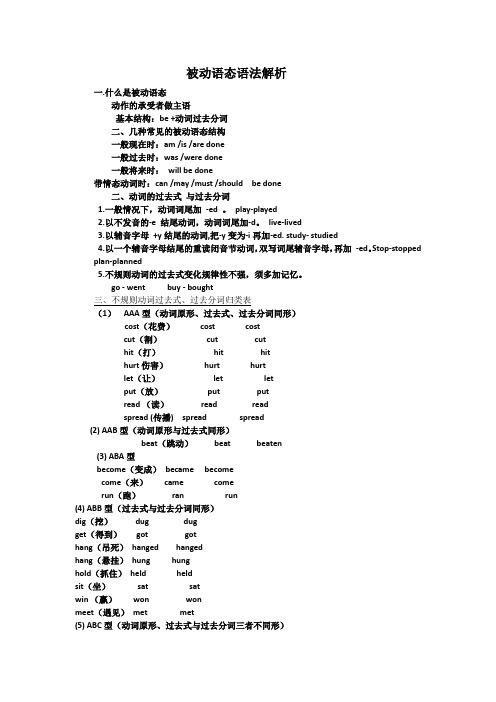
被动语态语法解析一.什么是被动语态动作的承受者做主语基本结构:be +动词过去分词二、几种常见的被动语态结构一般现在时:am /is /are done一般过去时:was /were done一般将来时:will be done带情态动词时:can /may /must /should be done二、动词的过去式与过去分词1.一般情况下,动词词尾加-ed 。
play-played2.以不发音的-e 结尾动词,动词词尾加-d。
live-lived3.以辅音字母+y结尾的动词,把-y变为-i再加-ed. study- studied4.以一个辅音字母结尾的重读闭音节动词,双写词尾辅音字母,再加-ed。
Stop-stoppedplan-planned5.不规则动词的过去式变化规律性不强,须多加记忆。
go - went buy - bought三、不规则动词过去式、过去分词归类表(1)AAA型(动词原形、过去式、过去分词同形)cost(花费) cost costcut(割) cut cuthit(打) hit hithurt 伤害) hurt hurtlet(让) let letput(放) put putread (读) read readspread (传播) spread spread(2) AAB型(动词原形与过去式同形)beat(跳动) beat beaten(3) ABA型become(变成)became becomecome(来) came comerun(跑) ran run(4) ABB型(过去式与过去分词同形)dig(挖)dug dugget(得到)got gothang(吊死) hanged hangedhang(悬挂) hung hunghold(抓住) held heldsit(坐)sat satwin (赢)won wonmeet(遇见) met met(5) ABC型(动词原形、过去式与过去分词三者不同形)begin(开始)began begundrink(喝) drank drunkring(铃响)rang rungsing (唱) sang sungswim(游泳)swam swumblow(吹)blew blowndraw (画)drew drawnfly(飞)flew flowngrow(生长)grew grownknow(知道)knew knownthrow(投掷)threw thrownshow(出示)showed shown四、变为被动语态They make shoes in that factory.主语+及物动词+宾语Shoes are made (by them) in that factory.•1. They play football on Sunday.••2. Lucy does the homework in the evening.••3. They don’t often use computers in class.•4. Do you make these machines in Beijing?They bought ten computers last term.Ten computers were bought (by them) last term.•1. They built the tall building last year.••2. He took good care of his little brother yesterday.••3. Did you clean the classroom just now?•4. They didn’t use this room for resting.They will finish the work in ten days.The work will be finished (by them)in ten days.•1. We will have a sports meeting next week.••2. Children won’t take some photos in the schoolyard tomorrow.••3. Will the headmaster give a talk this afternoon?五、翻译句子• 1 我的房间每天都被清洗•• 2 我的房间昨天被清洗了•• 3 我的房间明天将会被清洗•• 4 我的房间应该被清洗•六、Exercise : 把下面的句子改成被动语态• 1.They often use computers in class.•Computers _____________ by them in class.• 2.We cleaned our classroom just now.•Our classroom ___________ by us just now.• 3.The headmaster will give a talk this afternoon.• A talk ___________ by the headmaster this afternoon.•七、Put the following into passive voice:• 1.I can finish my homework every day.•• 2.Did they buy many flowers?•• 3.He doesn’t often read English.•• 4.They told us not to go there.••八、注意问题• 1. 在hear,see,watch,notice等“感观”动词的后面和make,let等“使役”动词的后面作宾补的动词不定式都不带to,但这种句子在变为被动语态时,应加上to。
(完整)初中英语被动语态讲解
初中英语被动语态解说英语动词有两种语态:主动语态和被动语态。
主动语态表示主语是动作的履行者,被动语态表示主语是动作的蒙受者。
一、被动语态的组成英语动词的被动语态由助动词be+及物动词的过去分词组成。
助动词be一定与主语的人称和数目保持一致,态的变化。
比如:The man was fooled by the two boys.The book has been translated into several languages.二、被动语态的用法( 1)动作的履行者不知道是谁或难以说明经常用被动语态。
比如:并有时Street lights are often turned on at six in winter.The new test book will be used next term.( 2)当动作的蒙受者比起动作的履行者来说更能惹起人们的关怀而需要加以重申时,要用被动语态。
比如:This kind of bicycle is not sold in our shop.The thief was caught by a policeman yesterday.( 3)含有双宾语的句子,主动句中的间接宾语或许直接宾语都可变为被动语态中的一个主语,另一个保存不变。
变为主语的假如主动句中的直接宾语在变为间接宾语前则需加介词to 或 for。
比如: The pianist gave the pupils( 间接宾语 )some advice(直接宾语 )→The pupils were given some advice by the pianist. → Some advice was given to the pupils by the pianist.(4)在主动语态句中动词make、have、let、see、watch 、hear、feel 等后接动词不定式作宾语补足语,动词不定式不加to。
初三的英语被动语态详细讲解
3. 当此动词表示事物的自然属性的时候:
•The pen _________ (write) vewrryitfeasst.
•This kind of sweater _______ (sell) well.
sells
变被动语态:
1 . He tells us a story every evening . We are told a story by him every evening . A story is told to us by him every evening .
主
谓
宾(受动者)
Bowls every day.
are washed
by his brother
2. They bought ten computers last term.
Ten computers were bought (by them) last term. 一般过去时:S+was/were +过去分词
S + will+be+过去分词.
1.一般现在时 am/is/are +done
• We clean the classroom every day. • The classroom is cleaned by us every day.
返回
2.一般过去时 was/were+done
He made the kite. The kite was made by him.
11. I won’t write to my grandpa this evening . My grandpa won’t be written to this evening by me .
初三英语被动语态讲解基本句型
被动语态I、被动语态的构成形式be+Vt.p.p.(一).语态是英语动词的一种形式,是用于表示主语和谓语之间的关系的。
英语语态分为主动语态(active voice)和被动语态(passive voice)两种。
主动语态是表示主语是动作的执行者。
如:1)Yesterday I parked my car outside the school.被动语态是表示主语是动作的承受者。
2)A sound of piano is heard in the hall.(二).被动语态的基本时态变化在被动语态的句子中,谓语部分的结构是be + Vtp.p.(及物动词过去分词)。
其中be是变量,随时态的变化而变化;动词的过去分词是常量,永远不发生变化。
当然,这只是指谓语部分而言。
be动词作为一个独立的谓语动词有自己现在分词(being)和过去分词(been)。
那么,下面我们来看看be在各种时态中的变化形式被动语态通常为八种时态的被动形式。
以do为例,各种时态的被动语态形式为:1)am/is/are +done (过去分词)一般现在时2)has /have been done 现在完成时3)am/is /are being done 现在进行时4)was/were done一般过去时5)had been done过去完成时6)was/were being done过去进行时7)shall/will be done一般将来时8)should/would be done过去将来时我们可看看下面的实例:English is spoken in many countries all over the world .(一般现在时)世界上许多国家都讲英文。
Some TV sets for sale in the department store were stolen last night.(一般过去时)那家商场用来出售的部分电视机昨晚被盗。
初三英语第九单元语法被动语态讲解
初三英语被动语态讲解◆一、什么是被动语态?英语中时态很多,但语态不多,只有两种,即:主动语态和被动语态。
所谓“被动语态”,相当于中文中常说的“被……”、“由……”的句式,如:“他的自行车被偷了。
”,“这座楼房是由他们建造的。
”◆二、被动语态的结构那么,英语中被动语态是怎么样构成的呢?请看下面的例句(注意划线部分):His bicycle was stolen.The building has been built in 2000.通过上面的例句,可以看出,“被动语态”的构成是:be + 过去分词+ (by+动作执行者)◆三、被动语态的运用什么情况下要用被动语态呢?一般地说,有下面几种情况:(1)不知道谁是动作的执行者或没有必要。
例如:Paper is made from wood. (纸是由木材生产出来的。
)The house is quite old. It was built in 1950. (这座房子太旧了。
它是1950年建成的。
)Printing was introduced into Europe from China.(2)需要强调动作的对象时。
例如:Calculator can't be used in the maths exam. (计算器不能用于数学考试。
)Books and newspapers in the reading room mustnt be taken away. (阅览室的书籍和报纸不准带走。
)He was awarded first prize in that contest. (他在比赛中获得了第一。
◆四、各种时态的被动语态举例一般地讲,被动语态可用于英语的各种时态。
为了能准确地运用被动语态,重点是要掌握be动词的各种时态变化。
各种时态的被动语态举例如下:1、一般现在时的被动语态. am / is / are + 动词的过去分词Our classroom is cleaned every day.This car is made in China.2、一般过去式的被动语态: was / were + 动词的过去分词His desk was cleaned just now.The station was built in 1928.3、现在进行时的被动语态: am / is / are + being + 动词的过去分词A new factory is being built in our city now.Some trees are being cut down in the park.4、过去进行时的被动语态: was / were + being + 动词的过去分词A new factory was being built in our city at that time.Some babies were being looked after by Miss Chen last year.5、一般将来时的被动语态:(A) will / shall + be + 动词的过去分词(B) am / is / are + going to be +动词的过去分词.Some new factories will be built in our city this year.Y our watch is going to be mended in an hour.6、过去将来时的被动语态: (1).would / should + be + 动词的过去分词(2).was / were+going to be + 动词的过去分词.She said that some new factories would be built soon in our city.He thought that your watch was going to be mended after an hour.7、现在完成时的被动语态:have / has + been + 动词的过去分词Some new factories have been built in the city since last year.Y our watch has been mended already.8、过去完成时的被动语态:had + been + 动词的过去分词He said that some new factories had been built in the city.I didn’t know that my watch had been mended .9、含情态动词的被动式:can/may/must + be + done例如:He can not be found. / I must be paid for this.五、如何将主动语态变成被动语态1、从句子意义上说,就是重新找出“什么事物”是“被完成”的。
- 1、下载文档前请自行甄别文档内容的完整性,平台不提供额外的编辑、内容补充、找答案等附加服务。
- 2、"仅部分预览"的文档,不可在线预览部分如存在完整性等问题,可反馈申请退款(可完整预览的文档不适用该条件!)。
- 3、如文档侵犯您的权益,请联系客服反馈,我们会尽快为您处理(人工客服工作时间:9:00-18:30)。
初三英语被动语态练习(2016.10.23)语法专练---被动语态一、语态概述我吃了一个苹果,那现在苹果怎样了?苹果被我吃了。
正如汉语中的被字句,英语中的“被字句”我们称之为被动语态。
英语中有两种语态:主动语态和被动语态。
英语的语态是通过动词形式的变化表现出来的。
主动语态表示主语是动作的执行者。
巧记为:主动、主动、主去动。
例如:Many people speak English.谓语:speak的动作是由主语many people来执行的。
被动语态表示主语是动作的承受者,即行为动作的对象。
巧记为:被动、被动、主被动。
例如:English is spoken by many people.主语English是动词speak的承受者。
例如:He opened the door.他开了门。
(主动句) The door was opened.门被开了。
(被动句) 二、被动语态的构成被动语态由“be+及物动词的过去分词”构成。
不及物动词本身没有被动语态。
及物动词---本身意义不完整,后必须带宾语,有些还可以带双宾。
不及物动词---本身意义完整,不需要带宾语,如带宾语必须通过介词。
人称、数和时态的变化是通过be的变化表现出来的。
现以eat为例说明被动语态在各种时态中的构成。
一般现在时:am/is/are+eaten 一般过去时:was/were+eaten一般将来时:will/shall/be going to be+eaten 过去将来时:would/should/be going to be+eaten现在进行时:am/is/are being+eaten 过去进行时:was/were being+eaten 现在完成时:have/has been+eaten 过去完成时:had been+eaten歌诀是:被动语态be字变,过去分词跟后面。
三、被动语态的用法(1)不知道或没有必要说明动作的执行者是谁。
例如:some new computers were stolen last night. 一些新电脑在昨晚被盗了。
(不知道电脑是谁偷的)This book was published in 1981.这本书出版于1981年。
(没有必要或说出出版者)(2)强调动作的承受者,而不强调动作的执行者。
例如:The window was broken by mike.窗户是迈克打破的。
This book was written by Lunxun.这本书是他写的。
Eight hours per day for sleep must be guaranteed.每天8小时睡眠必须得到保证。
歌诀:谁做的动作不知道,说出谁做的没有必要;动作承受者需强调,被动语态运用到。
(3) 为了更好地安排句子。
例The well-known person got on the bus and was immediately recognized by people. (一个主语就够了)四、主动语态变被动语态的方法(1)把主动语态的宾语变为被动语态的主语。
(2)把谓语变成被动结构(be+过去分词)(根据被动语态句子里的主语的人称和数,以及原来主动语态句子中动词的时态来决定be的形式)。
(3)把主动语态中的主语放在介词by之后作宾语,将主格改为宾格。
例如:All the people laughed at him. ---- He was laughed at by all people.They make the bikes in the factory. ----The bikes are made by them in the factory.歌诀是:宾变主,主变宾,by短语后面跟。
谓语动词变被动,be后“过分”来使用。
五、含有情态动词的被动语态含有情态动词的主动句变成被动句时,由“情态动词+be+过去分词”构成,原来带to的情态动词变成被动语态后“to”仍要保留。
歌诀是:情态动词变动,情态加be加“过分”。
例如: we can repair this watch in two days. --This watch can be repaired in two days. We must finish this work soon. --This work must be done soon.六、主动语态变被动语态需要注意的几个问题.(1)时态保持一致。
I have repaired my computer.---My computer has been repaired.(2)谓语为动词短语的被动语态不能丢掉动词短语的介词或副词。
His best friend often looks after him. --He is often looked after by his best friend.(3)主动语态中若有双宾语,将其中一个宾语变为被动句的主语,另一个宾语不变。
动词make/buy//get用for;动词give//send/lend/take用to)Vivian gave me a book. (双宾语,人间物直, me为间接宾语,a book 为直接宾语)-- I was given a book by Vivian.--A book was given to me by Vivian.(直接宾语提前时,要在间接宾语前加介词)(4)主动语态若有复合宾语,(即句子结构为主+及物动词+宾+宾补),将主动句的宾语变为被动句的主语,宾补不变。
They call him Louis. --He is called Louis.(5)当“动词+宾语+宾语补足语”结构变为被动语态时,将宾语变为被动结构中的主语,其余不动。
例Someone caught the boy smoking a cigarette. 可改为The boy was caught smoking a cigarette.(6)主动语态句中动词make, have, let(使sb做sth), notice. see. watch, look at, hear, listen to, feel等变成被动语态时,后面的不定式需要加上to.Mr. Lee made him wash the dishes. --He was made to wash the dishes.(7)有些相当于及物动词的动词词组,如“动词+介词”,“动词+副词”等,也可以用于被动结构,但要把它们看作一个整体,不能分开。
其中的介词或副词也不能省略。
例The meeting is to be put off till Friday.(8)非谓语动词的被动语态 v.+ing 形式及不定式 to do 也有被动语态(一般时态和完成时态) 。
例I don't like being laughed at in the public.(9)It is said that+从句及其他类似句型一些表示“据说”或“相信”的动词如believe, consider, expect, report, say, suppose, think等可以用于句型“It+be+过去分词+that从句”或“主语+be+过去分词+to do sth.”。
有:It is said that… 据说,I t is reported that…据报道,It is believed that…大家相信,It is hoped that…大家希望,It is well known that…众所周知,It is thought that…大家认为,It is suggested that…据建议。
例It is said that the boy has passed the national exam. (=The boy is said to have passed the national exam. )七、谓语动词的主动形式表示被动意义1、(1).英语中有很多动词如 break,catch,clean,drive,lock,open,sell,read,write,wash等,当它们被用作不及物动词来描述主语特征时,常用其主动形式表达被动意义,主语通常是物。
例 This kind of cloth washes well.注意:主动语态表被动强调的是主语的特征,而被动语态则强调外界作用造成的影响。
试比较:The door won't lock.(指门本身有毛病)The door won't be locked.(指不会有人来锁门, 指“门没有锁”是人的原因)(2)表示“发生、进行”的不及物动词和短语,如:happen, last, take place, break out, come out, come about, come true, run out, give out, turn out等以主动形式表示被动意义。
例 How do the newspapers come out? 这些报纸是如何引出来的呢?(3)系动词没有被动形式, 但有些表示感受、感官的连系动词feel, sound, taste, book, feel等在主系表结构中常以主动形式表示被动意义。
例Your reason sounds reasonable2、在某些句型中可用动名词和不定式的主动形式表被动意义。
(1)在need,want,require, bear等词的后面,动名词用主动形式表示被动意义,其含义相当于动词不定式的被动形式。
例The house needs repairing(to be repaired).这房子需要修理。
(2)形容词worth后面跟动名词的主动形式表示被动含义,但不能跟动词不定式;而worthy 后面跟动词不定式的被动形式。
例The picture-book is well worth reading.(=The picture-book is very worthy to be read.)(3)动词不定式在名词后面作定语,不定式和名词之间有动宾关系时,又和句中另一名词或代词构成主谓关系, 不定式的主动形式表示被动含义。
例 I have a lot of things to do this afternoon. (to do与things是动宾关系,与I 是主谓关系。
)试比较:I’ll go to the post office. Do you have a letter to be posted? ( 此处用不定式的被动语态作定语表明you不是post动作的执行者。
